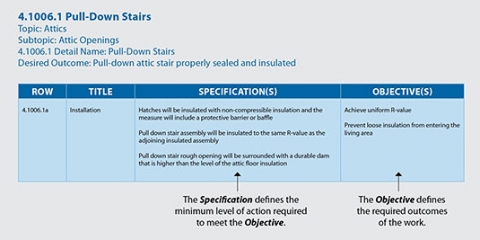By defining quality work through standard work specifications (SWS), the Guidelines for Home Energy Professionals project supports the development of a skilled residential energy upgrade workforce.
The SWS for single-family, multifamily, and manufactured housing describe acceptable outcomes for weatherization or home performance upgrades—effective, durable, and safe improvements for that housing type.
The SWS reflect a whole-house approach to installing energy-efficiency measures, which can include ventilation, insulation, and air sealing. By developing industry-approved work specifications and defining quality work, the SWS help establish residential energy upgrades as a national industry, and provide a common benchmark against which consumers, financers, and policymakers can measure performance of home energy-efficiency professionals.
Developing Standard Work Specifications
The National Renewable Energy Laboratory (NREL) and the U.S. Department of Energy's Weatherization Assistance Program (WAP) developed the standard work specifications in collaboration with industry subject matter experts, program administrators, health and safety experts, weatherization contractors, and product manufacturers. Federal partners at the U.S. Environmental Protection Agency (EPA), U.S. Department of Agriculture, and U.S. Department of Housing and Urban Development also contributed to the soundness of the SWS.
Safe work practices, relevant codes, and EPA Healthy Indoor Environment Protocols for Home Energy Upgrades are included in the SWS, which were also thoroughly vetted in an extensive public and industry review process.
Defining Quality Work
Rather than prescribing specific actions, materials, or techniques, standard work specifications identify outcomes for the energy-efficiency measure, listing the minimum set of requirements necessary to meet those outcomes. This approach allows for process innovation and changes in technology and is designed to encourage the private market to stay engaged in the ever-evolving weatherization industry.
The SWS serve as a universal resource for the home energy upgrade industry, giving home energy contractors and employers, utility and energy efficiency program administrators, home energy workers, training centers, and homeowners and consumers the same baseline for residential energy upgrades.
Measuring Performance
In Figure 1, the Objectives column describes the required outcomes for the efficiency measure and the Specificationscolumn describes the work required to achieve the outcome.
Figure 1. Sample standard work specification
Using these objectives and specifications, a training program can outline the purpose and requirements of a task. Trainers and work crews can choose the materials and techniques best suited to the project objectives. Inspectors can make objective decisions based on a measurable set of outcomes. Stakeholders know what to expect from retrofit work and can hold contractors accountable.

For interactive SWS content and resources, view the online SWS tool.
Conducting Home Energy Audits
Standard work specifications do not specifically address the process of energy assessments. A qualified auditor must first conduct an energy assessment and develop a list of recommended measures. The SWS can then be used to define the required outcomes of those measures and to assess the quality of the installed work.
Given the importance of the audit in successfully completing a home energy upgrade, WAP developed multiple resources to improve energy audits. Weatherization Assistant is an energy audit software tool that comprises:
- National Energy Audit Tool for site-built single-family houses
- Manufactured Home Energy Audit for manufactured housing
- Multifamily Tool for Energy Auditing for multifamily homes.

 Online Standard Work Specifications Tool
Online Standard Work Specifications Tool